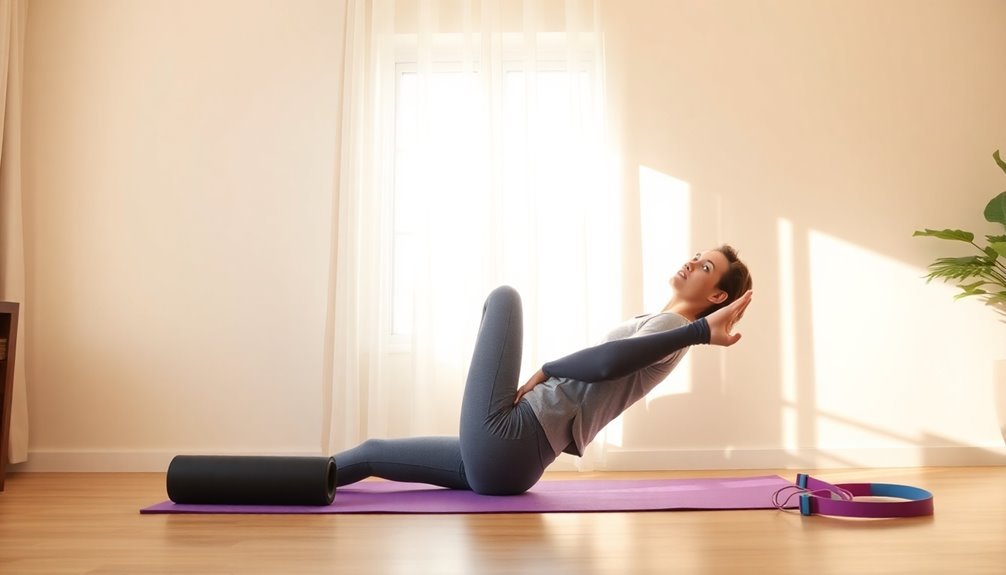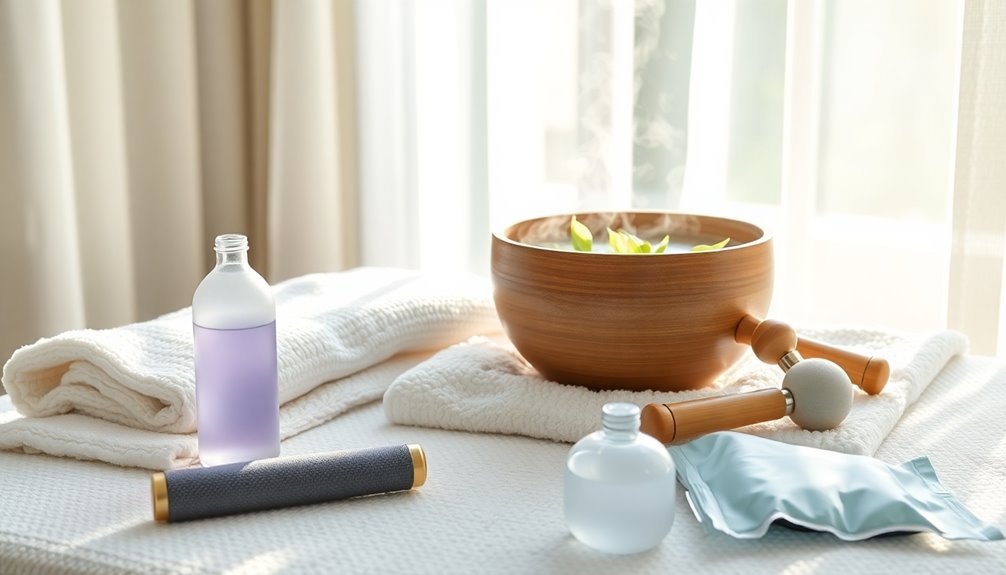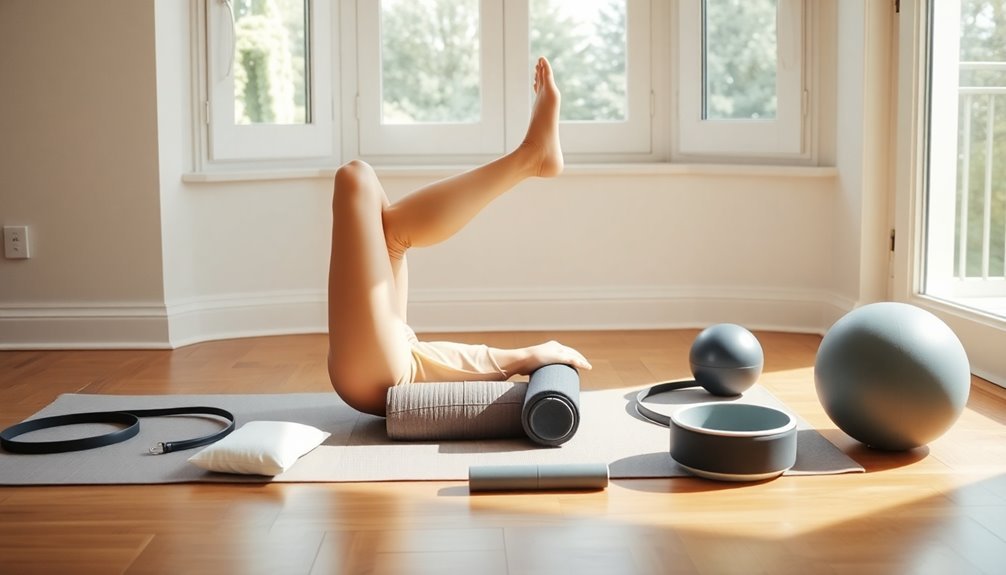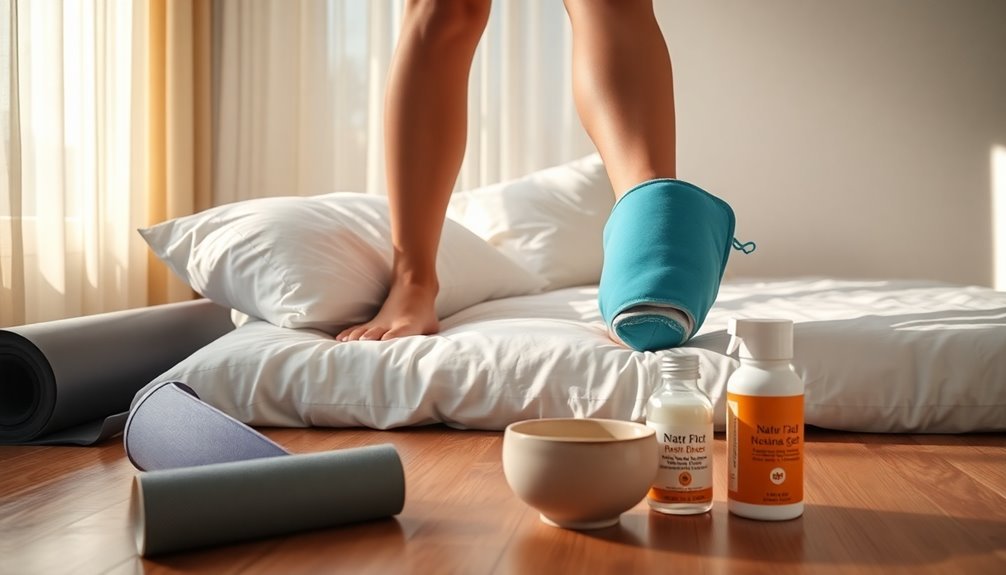You'll find quick relief from knee pain with these proven at-home therapies. Start with heat therapy using warm baths or heating pads to increase blood flow and relax muscles. Apply ice packs wrapped in a towel for 15-20 minutes to reduce swelling and inflammation. Strengthen your knee with gentle exercises like straight leg raises and clamshells. Try therapeutic massage with anti-inflammatory essential oils like eucalyptus or ginger. Practice the PRICE method (Protection, Rest, Ice, Compression, Elevation) for injury recovery. Use compression bandages or braces for support, and keep your movements low-impact. These strategies are just the beginning of your journey toward knee pain relief.
Natural Heat Treatments

Relief from knee pain starts with understanding the power of heat therapy. When you apply heat to your knee, it dilates blood vessels and increases circulation, helping your muscles relax and reduce stiffness. This natural approach works particularly well for chronic conditions like arthritis or pain that's lasted more than six weeks.
You'll find several effective ways to apply heat therapy at home. Try taking a warm bath with Epsom salts, which provides both heat and magnesium benefits. Regular soaking with two cups of salt can significantly reduce inflammation and knee discomfort.
You can enhance the therapeutic effects by adding anti-inflammatory essential oils like peppermint or frankincense.
If you prefer targeted treatment, use a heating pad on your knee for 10-15 minutes at a time, but always monitor your skin for excessive redness.
For an extra boost, consider combining heat therapy with natural remedies. Ginger and turmeric, known for their anti-inflammatory properties, can complement your heat treatment when consumed as tea or applied topically.
You can also try capsaicin-based ointments, which create a warming sensation while stimulating blood flow.
Remember to take breaks between heat applications to let your skin return to its normal temperature.
Cold Therapy Applications
When you're treating knee pain with cold therapy, you'll want to wrap an ice pack in a thin towel and apply it directly to the affected area for 10-20 minutes at a time.
For best results, you can repeat this process 4-8 times throughout the day, especially within the first 72 hours after injury or intense activity. To prevent potential skin damage, check your skin frequently for any signs of excessive redness or discomfort during treatment.
After exercise or sports, it's particularly effective to combine ice pack applications with elevation of your knee above heart level to maximize swelling reduction and pain relief.
Ice Pack Application Methods
For effective knee pain management, proper ice pack application serves as a crucial first-line treatment to reduce swelling and inflammation.
When applying an ice pack, you'll need to wrap it in a towel or cloth to create a protective barrier between the cold source and your skin, preventing frostbite and tissue damage.
Apply the ice pack for 20-minute intervals, removing it for an equal period between applications. While treating your knee, keep it elevated above heart level to minimize swelling and enhance circulation.
You can combine cold therapy with compression for better results and stability of the affected area. If you don't have a commercial ice pack, you can create one by sealing ice in a plastic bag. Repeat treatments every four to six hours to maintain the therapeutic benefits.
Monitor your skin frequently during treatment, checking for any signs of damage or excessive cold exposure. If you experience numbness or loss of sensation, stop the treatment immediately.
For the best results, pair your cold therapy with rest and over-the-counter pain medication as needed. Remember that cold therapy works best for acute injuries within the first 48 hours, while heat therapy is more suitable for chronic conditions.
Optimal Treatment Duration
Successfully managing knee pain through cold therapy requires following specific timing guidelines for best results. The ideal duration for applying ice or cold gel packs to your knee is 15-20 minutes per session. You'll want to avoid extending sessions beyond 20 minutes, as this can risk damaging your skin or underlying tissues. Proper cold therapy applications can help facilitate post-injury recovery and get you back to normal activities sooner.
During the first 24 hours after injury, you should apply cold therapy frequently to effectively reduce swelling and inflammation.
For maximum benefit, follow these key timing guidelines:
- Apply cold therapy 4-8 times daily during the first two days post-injury
- Space treatments throughout the day, allowing skin temperature to normalize between sessions
- Watch for skin sensitivity and adjust frequency if needed
- Maintain consistent 15-20 minute sessions, even when treating chronic pain
Always place a thin towel between the cold pack and your skin to prevent tissue damage. You'll need to monitor your skin's response during treatment and stop immediately if you experience numbness or increased pain.
If you're managing ongoing knee pain, you can combine cold therapy with other treatment methods like compression and elevation, adjusting the frequency based on your pain levels and healing progress.
Post-Activity Cooling Techniques
Applying cold therapy after physical activity can substantially reduce knee pain and inflammation when done correctly. You'll find several effective cooling methods to choose from, but it's critical to follow proper application techniques to prevent skin damage.
When applying cold therapy, always wrap ice packs or frozen items in a thin towel before placing them on your knee. Maintain the application for 10-20 minutes, and don't exceed this timeframe to avoid tissue damage. If you're dealing with post-surgery recovery or chronic conditions, you might benefit from using a cold therapy machine for more precise, controlled cooling. Professional cold therapy machines provide uniform cold distribution around the entire knee area for optimal pain relief.
| Method | Application Tips |
|---|---|
| Ice Packs | Wrap in towel, apply 10-20 minutes |
| Gel Packs | Freeze first, use cloth barrier |
| Cold Machine | Follow device instructions carefully |
| Frozen Veggies | Use flexible bags like peas |
| Compression Ice | Combine with elastic wrap |
Remember to check your skin's sensation regularly during treatment. If you have diabetes or circulation issues, consult your healthcare provider before starting cold therapy. You can enhance the effectiveness by combining it with rest, compression, and elevation as part of the RICE protocol.
Strengthening Exercise Program

A well-designed strengthening exercise program forms the cornerstone of effective knee pain management. You'll want to focus on exercises that target the muscles supporting your knee joint, including your quadriceps, hamstrings, and glutes.
Starting with gentle movements like quad sets and straight leg raises, you can gradually progress to more challenging exercises as your strength improves. Try performing exercises with your heels elevated during squats to increase quadricep activation.
To maximize your results and prevent further injury, incorporate these essential exercises into your daily routine:
- Perform quad sets and short arc quads to enhance muscle control and stability around your knee
- Try bridging exercises to strengthen your glutes and hamstrings without stressing the joint
- Include sidelying hip abduction to improve lateral stability and knee alignment
- Add low-impact activities like swimming or cycling as you build strength
You'll find that consistent practice leads to reduced pain and improved joint function over time.
Don't forget to start slowly and progress gradually – it's better to begin with fewer repetitions and perfect form than to risk aggravating your condition.
If you're unsure about proper technique, consider consulting a physical therapist who can tailor exercises to your specific needs.
Therapeutic Massage Techniques
Therapeutic massage offers powerful relief for knee pain by targeting the muscles and soft tissues surrounding your joint. You'll find several effective techniques that can help reduce inflammation, improve circulation, and release muscle tension around your knees. Massage therapy helps promote healing by releasing endorphins, which are natural painkillers produced by your body.
| Massage Type | Benefits |
|---|---|
| Swedish Massage | Improves blood flow with long, flowing strokes |
| Deep Tissue | Breaks up adhesions and increases range of motion |
| Trigger Point | Releases tight muscle knots causing pain |
| Cross-Fiber | Reduces inflammation and breaks down scar tissue |
| Shiatsu | Relieves tension through precise pressure points |
When performing self-massage, focus on the quadriceps just above your knee, the sides of your kneecap, and the back of your knee. Don't apply pressure directly on the kneecap itself. Instead, use gentle circular motions on the surrounding muscles, gradually increasing pressure as needed. You'll want to massage each knee for 5-10 minutes using kneading and gliding techniques. For enhanced results, try using essential oils like peppermint or eucalyptus. Position yourself on a firm surface with your knee bent and foot planted firmly for the most effective treatment.
Essential Oil Pain Relief

Essential oils like eucalyptus, frankincense, lavender, and ginger offer powerful natural anti-inflammatory properties for knee pain relief.
These oils work best when you blend them together and dilute them in carrier oils like coconut or jojoba for safe topical application.
For maximum benefit, gently massage the oil mixture into your knee using circular motions, focusing on tender areas while allowing time for the natural compounds to absorb into your skin.
Research shows highly concentrated plant extracts are particularly effective when properly diluted and applied to painful areas.
Best Essential Oil Blends
Essential oil blends offer powerful relief for stubborn knee pain when combined strategically. Research shows that certain combinations work better together, enhancing their pain-relieving and anti-inflammatory properties.
The most effective research-backed combinations for knee pain include:
- Lavender, juniper, ylang-ylang, and rosemary (5% mixture in coconut oil) – proven to reduce both pain and fatigue in rheumatoid arthritis patients
- Ginger and orange oil blend – specifically effective for moderate to severe osteoarthritis knee pain
- Frankincense and myrrh combination – shown to reduce joint inflammation in clinical studies
- Eucalyptus with carrier oil – helps reduce pain and lower blood pressure post-knee surgery
Before applying any blend, dilute the oils properly in a carrier oil like coconut or jojoba. Always do a patch test first to check for sensitivity.
Don't use these blends if you're pregnant or nursing without consulting your healthcare provider. Remember that essential oils aren't regulated, so source your products from reputable suppliers.
Application And Massage Methods
Proper application techniques transform the healing potential of essential oils into effective knee pain relief. For safe application, dilute your chosen essential oils in a carrier oil using specific ratios: 2.5% for general adult use and up to 10% for acute muscle pain.
Mix 10-15 drops of essential oil with 2 tablespoons of carrier oil before use.
To massage the affected area, position your leg with the foot firmly planted or your calf supported. Focus on the quadriceps above the knee, using gentle circular motions while avoiding direct pressure on the kneecap.
Apply the oil mixture using gliding movements above and below the knee, and squeeze-and-slide techniques around the surrounding muscles.
Spend 5-10 minutes massaging each knee, incorporating thigh tapping and front thigh glides to increase blood flow and reduce muscle tension. You can also massage your lower back to enhance overall mobility in the knee region.
Always test the oil mixture on a small patch of skin first, and adjust pressure based on your comfort level. Remember to avoid essential oil use if you're pregnant or applying it to children unless directed by a healthcare provider.
Natural Anti-inflammatory Properties
Through their natural compounds, several essential oils offer powerful anti-inflammatory properties that can help reduce knee pain and swelling. Research supports the effectiveness of oils like eucalyptus, which has shown promising results in reducing pain and lowering blood pressure after knee surgery.
Ginger oil, when used in massage, has demonstrated significant benefits in reducing osteoarthritis pain and stiffness.
Key essential oils proven to combat knee inflammation include:
- Frankincense – Contains natural acids that provide both anti-inflammatory and pain-relieving effects
- Lavender – Features active compounds that reduce inflammation while offering analgesic benefits
- Bergamot – Works through specific anti-inflammatory compounds to minimize joint discomfort
- Eucalyptus – Utilizes eucalyptol to decrease inflammation and associated pain
When using these oils for knee pain relief, you'll need to dilute them with carrier oils like coconut or sesame oil, which offer additional anti-inflammatory benefits. Remember to test any oil mixture on a small patch of skin first, as some people may experience sensitivity.
Don't apply these oils before sun exposure, particularly bergamot, as it can increase skin sensitivity to sunlight.
PRICE Method Implementation
A swift response to knee injuries can make all the difference in your recovery timeline. When you experience knee pain or injury, implementing the PRICE method immediately can help reduce swelling, minimize discomfort, and accelerate healing.
Start by protecting your knee from further damage using a brace or supportive bandage. You'll need to rest completely, which means stopping any activities that could worsen the injury.
Apply ice packs to your knee for 15-20 minutes every hour, making sure to wrap the ice in a thin towel to protect your skin.
Next, use compression by wrapping an elastic bandage around your knee – it should be snug but not too tight to restrict blood flow.
Finally, keep your knee elevated above your heart level whenever possible, especially when you're lying down or sitting.
While the PRICE method works well for minor knee injuries and strains, don't rely on it exclusively for severe injuries. If you experience intense pain, significant swelling, or inability to bear weight, you'll need to seek immediate medical attention for proper diagnosis and treatment.
Movement and Support Strategies

Maintaining mobility while protecting your knee requires a balanced approach of targeted exercises and appropriate support tools. You'll want to focus on gentle movements that strengthen the surrounding muscles while using proper support devices to prevent further strain.
Start with basic exercises like straight-leg raises and leg stretches, performing them in sets of 10 with each leg. As you build strength, incorporate functional movements such as step-ups and sit/stands into your routine.
Remember to move your knees gently every hour and gradually increase your activity level through walking or swimming.
Support your recovery with these essential tools and practices:
- Wear a compression knee sleeve during activities to provide stability and reduce swelling
- Use ice pack wraps after exercise to minimize inflammation
- Choose appropriate footwear that offers proper arch support and cushioning
- Lead with your stronger leg when descending stairs and always use handrails
Don't forget to maintain a healthy weight, as every pound lost substantially reduces pressure on your knee joint.
Progress gradually with your exercises and stop if you experience increased pain or discomfort.
Frequently Asked Questions
How Long Should I Wait After Knee Injury Before Starting Gentle Exercises?
You'll need to wait until your pain decreases and stability improves, typically several weeks. Always consult your doctor first, as recovery time varies based on your specific injury and healing progress.
Can Certain Foods or Supplements Help Reduce Knee Inflammation Naturally?
Yes, you can reduce knee inflammation with fatty fish, berries, and leafy greens. Supplements like glucosamine, turmeric, and omega-3s can also help. Pair these with anti-inflammatory foods like ginger and garlic.
What Shoes Are Best Recommended for People With Chronic Knee Pain?
You'll find the best relief with brands like New Balance, Brooks, and Hoka One One. Look for shoes with strong stability, ample cushioning, and good arch support to effectively manage your knee pain.
How Often Should Knee Braces Be Replaced for Optimal Support?
You'll need to replace your knee brace every 6-12 months if you use it regularly. Check for signs of wear, and consult your healthcare provider, as replacement timing varies based on usage, material, and condition.
Is It Normal for Knee Pain to Increase During Weather Changes?
Yes, it's completely normal for your knee pain to increase during weather changes. You'll often notice more discomfort when temperatures drop, barometric pressure shifts, or humidity rises. This is especially common with arthritis.
In Summary
You've got multiple options to manage knee pain effectively from home. Whether you're applying heat, ice, doing exercises, or trying essential oils, consistency is key for the best results. Remember to listen to your body and adjust these therapies as needed. If pain persists or worsens, don't hesitate to consult your healthcare provider. With proper care and patience, you can work toward reducing your knee discomfort.





Leave a Reply